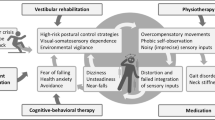Abstract
Background
Phobic postural vertigo is characterized by dizziness in standing and walking despite normal clinical balance tests. Patients sometimes exhibit anxiety reactions and avoidance behavior to specific stimuli. Different treatments are possible for PPV, including vestibular rehabilitation exercises, pharmacological treatment, and cognitive behavioral therapy. We recently reported significant benefits of cognitive behavioural therapy for patients with phobic postural vertigo. This study presents the results of a one-year follow-up of these patients.
Methods
Swedish translations of the following questionnaires were administered: (Dizziness Handicap Inventory, Vertigo Symptom Scale, Vertigo Handicap Questionnaire, and Hospital Anxiety and Depression Scale) were administered to 20 patients (9 men and 11 women; mean age 43 years, range 23–59 years) one year after completion of cognitive behavioral therapy.
Results
Test results were similar to those obtained before treatment, showing that no significant treatment effects remained.
Conclusion
Cognitive behavioral therapy has a limited long-term effect on phobic postural vertigo. This condition is more difficult to treat than panic disorder with agoraphobia. Vestibular rehabilitation exercises and pharmacological treatment might be the necessary components of treatment.
Similar content being viewed by others
References
Bakker A, van Balkom AJ, Spinhoven P, Blaauw BM, van Dyck R (1998) Follow-up on the treatment of panic disorder with or without agoraphobia: a quantitative review. J Nerv Ment Dis 186:414–419
van Balkom AJ, Bakker A, Spinhoven P, Blaauw BM, Smeenk S, Ruesink B (1997) A meta-analysis of the treatment of panic disorder with or without agoraphobia: a comparison of psychopharmacological, cognitive-behavioral, and combination treatments. J Nerv Ment Dis 185:510–516
Brandt T (1996) Phobic postural vertigo. Neurology 46:1515–1519
Brandt T, Huppert D, Dieterich M (1994) Phobic postural vertigo: a first follow-up. J Neurol 241:191–195
Holmberg J, Karlberg M, Fransson PA, Magnusson M (2003) Phobic postural vertigo: body sway during vibratory proprioceptive stimulation. Neuroreport 14:1007–1011
Holmberg J, Karlberg M, Harlacher U, Rivano-Fischer M, Magnusson M (2005) Treatment of phobic postural vertigo A controlled study of cognitive-behavioral therapy and self-controlled desensitization. J Neurol
Huppert D, Strupp M, Rettinger N, Hecht J, Brandt T (2005) Phobic postural vertigo-a long-term follow-up (5 to 15 years) of 106 patients. J Neurol 252:564–569
Jacob RG, Whitney SL, Detweiler-Shostak G, Furman JM (2001) Vestibular rehabilitation for patients with agoraphobia and vestibular dysfunction: a pilot study. J Anxiety Disord 15:131–146
Jacobson GP, Newman CW (1990) The development of the dizziness handicap inventory. Arch Otolaryngol Head Neck Surg 116:424–427
Krafczyk S, Schlamp V, Dieterich M, Haberhauer P, Brandt T (1999) Increased body sway at 3.5–8 Hz in patients with phobic postural vertigo. Neurosci Lett 259:149–152
Mendel B, Bergenius J, Langius A (1999) Dizziness symptom severity and impact on daily living as perceived by patients suffering from peripheral vestibular disorder. Clin Otolaryngol Allied Sci 24:286–293
Pavlou M, Lingeswaran A, Davies RA, Gresty MA, Bronstein AM (2004) Simulator based rehabilitation in refractory dizziness. J Neurol 251:983–995
Querner V, Krafczyk S, Dieterich M, Brandt T (2002) Phobic postural vertigo. Body sway during visually induced roll vection. Exp Brain Res 143:269–275
Staab JP, Ruckenstein MJ, Amsterdam JD (2004) A prospective trial of sertraline for chronic subjective dizziness. Laryngoscope 111:1637–1641
Yardley L, Burgneay J, Andersson G, Owen N, Nazareth I, Luxon L (1998) Feasibility and effectiveness of providing vestibular rehabilitation for dizzy patients in the community. Clin Otolaryngol Allied Sci 23:442–448
Yardley L, Luxon L (1994) Treating dizziness with vestibular rehabilitation. Bmj 308:1252–1253
Yardley L, Masson E, Verschuur C, Haacke N, Luxon L (1992) Symptoms, anxiety and handicap in dizzy patients: development of the vertigo symptom scale. J Psychosom Res 36:731–741
Yardley L, Putman J (1992) Quantitative analysis of factors contributing to handicap and distress in vertiginous patients: a questionnaire study. Clin Otolaryngol Allied Sci 17:231–236
Zigmond AS, Snaith RP (1983) The hospital anxiety and depression scale. Acta psychiatr scand 67:361–370
Author information
Authors and Affiliations
Corresponding author
Rights and permissions
About this article
Cite this article
Holmberg, J., Karlberg, M., Harlacher, U. et al. One-year follow-up of cognitive behavioral therapy for phobic postural vertigo. J Neurol 254, 1189–1192 (2007). https://doi.org/10.1007/s00415-007-0499-6
Received:
Revised:
Accepted:
Published:
Issue Date:
DOI: https://doi.org/10.1007/s00415-007-0499-6




